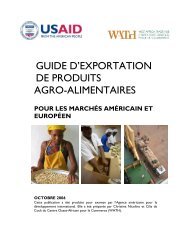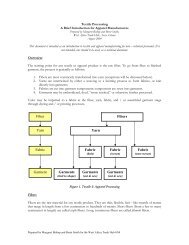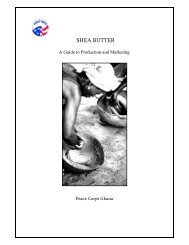A Value Chain Analysis of the Cashew Sector - AGOA Export Toolkit
A Value Chain Analysis of the Cashew Sector - AGOA Export Toolkit
A Value Chain Analysis of the Cashew Sector - AGOA Export Toolkit
Create successful ePaper yourself
Turn your PDF publications into a flip-book with our unique Google optimized e-Paper software.
or estimating harvest volumes at particular times. Also, mapping<br />
allows for traceability which is a critical requirement for<br />
certifi cation. Recently, TIPCEE, Technoserve and CDP jointly<br />
organised a Training <strong>of</strong> Trainers workshop for selected extension<br />
staff on quality standards and norms for cashew. Th e<br />
major outputs expected from such workshops include training<br />
and <strong>the</strong> sensitisation <strong>of</strong> farmers towards producing good quality<br />
RCN for domestic and export markets. Table 2.13<br />
on page 32 summarises programmes/projects involved<br />
in promoting <strong>the</strong> cashew value chain in Ghana.<br />
2.9 Opportunities and Bottlenecks for Promoting <strong>the</strong><br />
<strong>Cashew</strong> <strong>Value</strong> <strong>Chain</strong> in Ghana<br />
Th e most important problems/ bottlenecks within <strong>the</strong> cashew<br />
value chain in Ghana are:<br />
ÿ Diffi culty in accessing farm inputs and good planting<br />
materials: Th e existing distribution system for farm inputs<br />
is generally weak and characterised by a lack <strong>of</strong><br />
funds, unreliable suppliers and poor infrastructure<br />
(feeder road networks, storage facilities) in rural areas.<br />
Fur<strong>the</strong>rmore, farmers lack access to agro-chemicals needed<br />
for increasing <strong>the</strong> productivity <strong>of</strong> cashew farming.<br />
ÿ High incidence <strong>of</strong> pest infestations: Devastating eff ects<br />
from sucking pests (Helopeltis spp, Anoplocnemis curvipes,<br />
Pseudo<strong>the</strong>raptus devastems) and stem borers (Apate telebrans)<br />
lead to secondary infections and subsequent losses<br />
in yield and quality.<br />
ÿ Inadequate extension services: Th ere is insuffi cient dissemination<br />
<strong>of</strong> research fi ndings g due to inadequate q exten-<br />
sion services services and high extension worker-farmer<br />
ratios<br />
(1: at least 500).<br />
ÿ High interest rates and lack <strong>of</strong> working capital: High<br />
interest rates charged by fi nancial institutions on loans<br />
and overdrafts are said to be one <strong>of</strong> <strong>the</strong> major factors<br />
negatively impacting processing. Also, lack <strong>of</strong> working<br />
capital prevents <strong>the</strong> expansion <strong>of</strong> processing companies.<br />
ÿ Inconsistent supply <strong>of</strong> RCN to processing companies:<br />
although RCN are exported, <strong>the</strong>re is an inadequate<br />
supply to meet <strong>the</strong> needs <strong>of</strong> existing local processing<br />
companies.<br />
ÿ Weak farmer associations: Th ese associations do not<br />
have a strong enough collective voice to promote <strong>the</strong><br />
interests <strong>of</strong> <strong>the</strong>ir members when it comes to selling RCN.<br />
Th us, <strong>the</strong>ir members lack <strong>the</strong> bargaining power needed<br />
for negotiations with traders.<br />
ÿ Inadequate transport facilities and frequent fl uctuations<br />
in <strong>the</strong> price <strong>of</strong> fuel have resulted in high cashew<br />
transport costs.<br />
ÿ Lack <strong>of</strong> an eff ective marketing information system for<br />
monitoring and analysing global products and market<br />
trends, and for relaying <strong>the</strong> information ga<strong>the</strong>red to<br />
stakeholders in <strong>the</strong> sector.<br />
ÿ Frequent bush fi res.<br />
Th e most important opportunities for <strong>the</strong> cashew<br />
value chain in Ghana are:<br />
ÿ Increased global demand for cashews<br />
ÿ Availability <strong>of</strong> land in environments suitable<br />
for cashew production<br />
ÿ Increased farmer interest in cashew production<br />
due to a fl ourishing export market<br />
ÿ Th e enabling g environment facilitated by y ggovernment sup- p<br />
port for for infrastructure support (e.g. 70% <strong>of</strong><br />
<strong>the</strong> feeder roads in major producing<br />
areas areas have been rehabilitated)<br />
33









